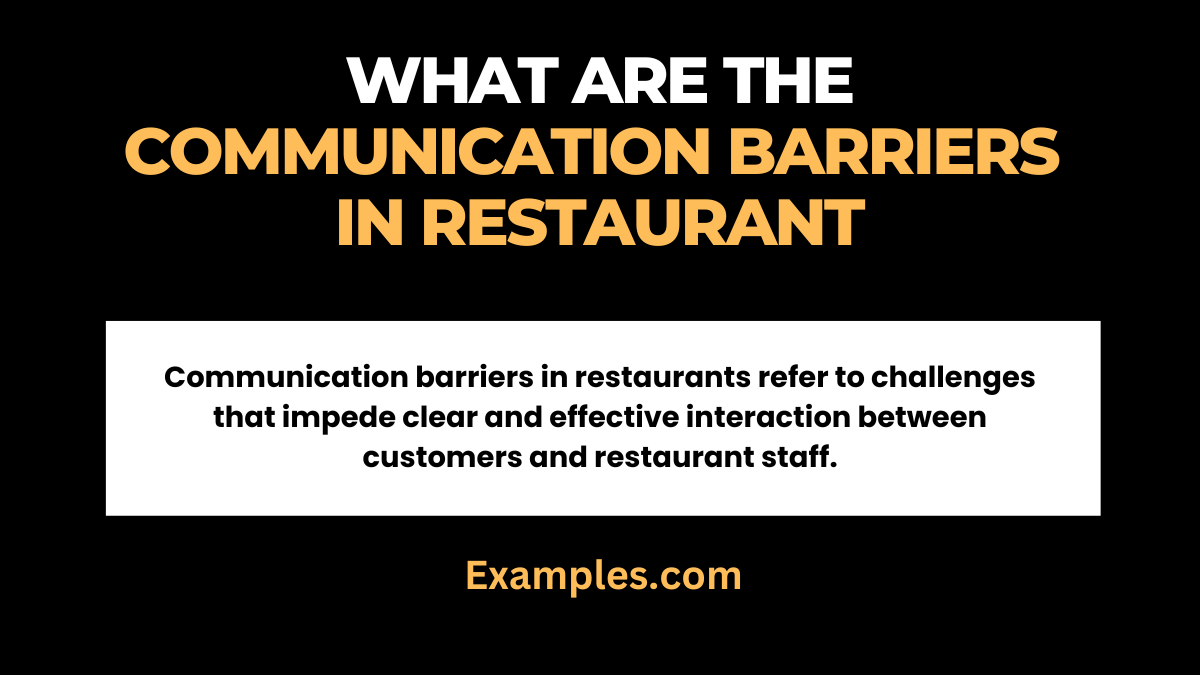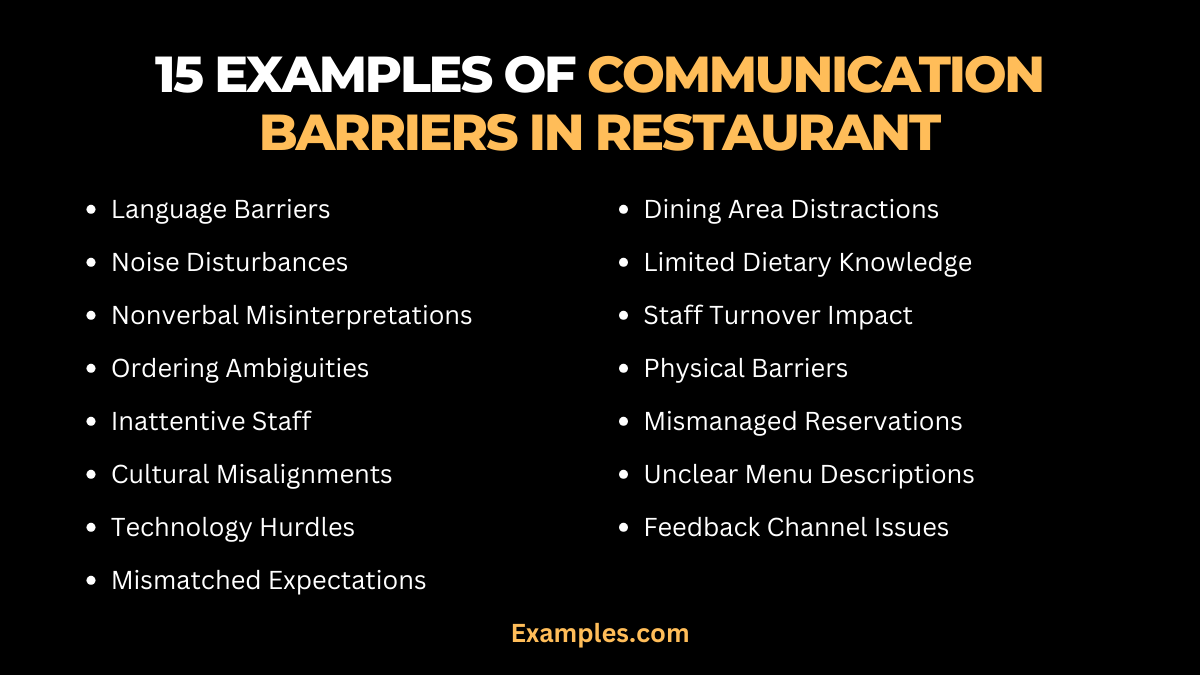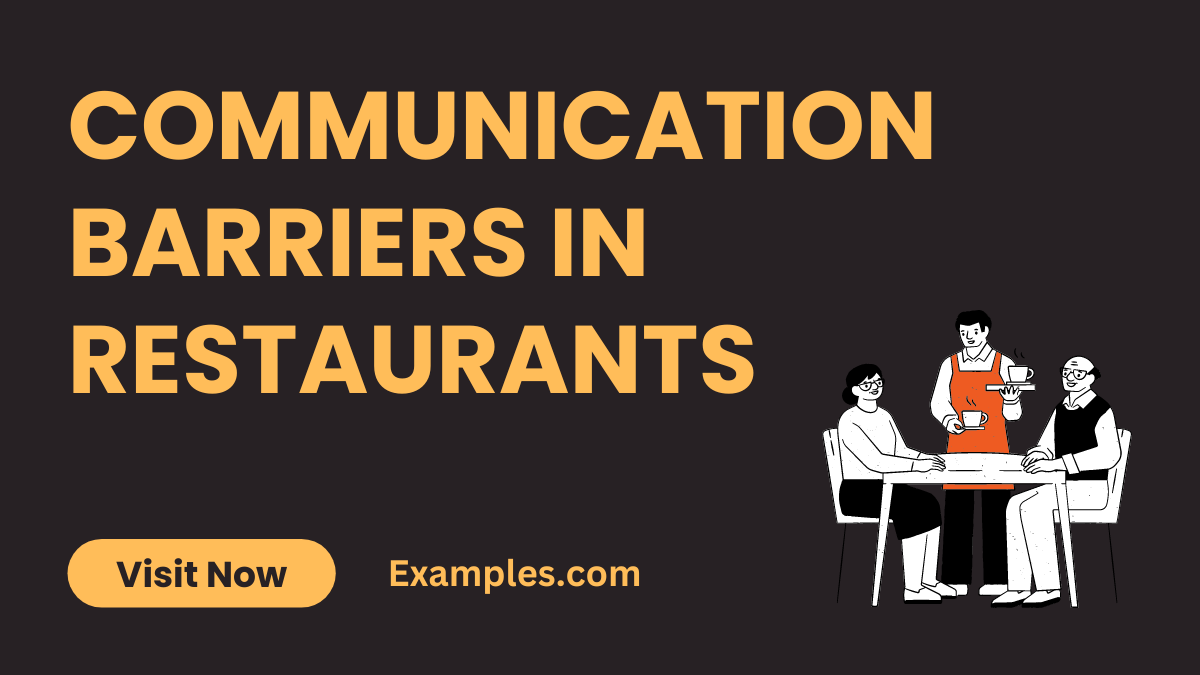Communication Barriers in Restaurants
Embark on a gastronomic journey as we unravel the intricate tapestry of “Communication Barriers in Restaurants.” This comprehensive guide explores the nuances that can hinder seamless interactions between customers and staff, offering practical solutions to enhance dining experiences. Dive into real-world Communication Examples, discover effective strategies, and ensure a delightful rendezvous where communication elevates the gastronomic journey. Join us on this culinary exploration where understanding and overcoming communication barriers enrich the restaurant experience for patrons and staff alike.
What Are The Communication Barriers In Restaurants

Communication barriers in restaurants refer to challenges that impede clear and effective interaction between customers and restaurant staff. These obstacles can manifest through misunderstandings, language differences, or nonverbal cues. In simpler terms, they are the hurdles that hinder smooth communication, impacting the overall dining experience. This guide delves into understanding, identifying, and addressing these barriers, aiming to enhance communication and ensure a seamless and enjoyable interaction in restaurant settings.
15 Examples of Communication Barriers in Restaurant
Explore the intricate dynamics of dining interactions with our guide on 15 Communication Barriers in Restaurants. Uncover challenges that may disrupt the flow of customer-staff communication, and learn practical strategies to overcome these obstacles for a more enjoyable dining experience.

- Language Barriers: Misunderstandings due to diverse languages.
Example: Use simple language and gestures for clarity in communicating menu choices. - Noise Disturbances: Loud environments impact communication.
Example: Optimize seating arrangements to minimize noise interference during customer-server discussions. - Nonverbal Misinterpretations: Mixed signals affecting understanding.
Example: Ensure staff receives nonverbal cues accurately by actively listening and observing customer expressions. - Ordering Ambiguities: Confusion in menu interpretations.
Example: Encourage customers to ask clarifying questions to avoid ordering misunderstandings. - Inattentive Staff: Lack of staff responsiveness disrupts service.
Example: Train staff to prioritize attentiveness, ensuring prompt response to customer needs. - Cultural Misalignments: Diverse cultural norms influencing interactions.
Example: Sensitize staff to cultural differences, promoting understanding in customer engagement. - Technology Hurdles: Technical issues with ordering systems.
Example: Regularly update and maintain digital menus to prevent technological glitches that may hinder orders. - Mismatched Expectations: Differing customer and staff expectations.
Example: Set clear expectations regarding service speed and quality to align with customer preferences. - Dining Area Distractions: External factors diverting attention.
Example: Minimize disruptions in dining spaces to ensure customers can focus on communication with staff. - Limited Dietary Knowledge: Staff unawareness of dietary restrictions.
Example: Train servers to inquire about dietary preferences and provide informed recommendations. - Staff Turnover Impact: Frequent changes affecting familiarity.
Example: Foster a sense of continuity with regular staff briefings on regular patrons’ preferences. - Physical Barriers: Obstacles hindering face-to-face interaction.
Example: Optimize restaurant layout for clear lines of sight between customers and staff. - Mismanaged Reservations: Booking errors causing inconvenience.
Example: Implement a robust reservation system to prevent booking misunderstandings and customer dissatisfaction. - Unclear Menu Descriptions: Ambiguities in dish explanations.
Example: Ensure menus contain clear, concise descriptions to aid customers in making informed choices. - Feedback Channel Issues: Ineffective customer feedback avenues.
Example: Establish accessible channels for feedback, encouraging open communication for continuous improvement.
Communication Barriers in Restaurants for Customers
Embark on a gastronomic journey where we dissect the distinctive challenges customers face in restaurant communication. Uncover hurdles that may mar the dining experience, and explore practical solutions for customers to navigate these barriers seamlessly.
- Menu Complexity: Overly intricate menus may confuse customers.
Example: Boldly highlight signature dishes and simplify menu descriptions for clarity. - Server Rush: Overwhelmed staff can hinder attentive service.
Example: Implement effective floor management to distribute server workload and ensure optimal customer interaction. - Payment Process Confusion: Complex payment procedures may frustrate diners.
Example: Display clear payment instructions, guiding customers through the process for a smoother transaction. - Allergen Information Gap: Insufficient details on allergens can pose risks.
Example: Boldly state potential allergens on menus, aiding customers in making safe, informed choices. - Seating Preferences: Misunderstandings in seating requests.
Example: Train staff to actively listen and accommodate seating preferences, enhancing the overall dining experience.
Communication Challenges Between Restaurant Workers
Delve into the intricacies of communication challenges within restaurant teams. Uncover hurdles hindering seamless collaboration among workers and explore strategies to strengthen internal communication for enhanced operational efficiency.
- Kitchen-Server Communication Breakdown: Miscommunication impacting order accuracy.
Example: Implement a streamlined communication protocol for precise order transmission between kitchen and servers. - Language Diversity in the Kitchen: Varied linguistic backgrounds may lead to misunderstandings.
Example: Foster a multilingual kitchen culture, ensuring effective communication despite language differences. - Shift Change Handover Issues: Inadequate information transfer during shifts.
Example: Establish comprehensive handover procedures to ensure a seamless transition of tasks and responsibilities. - Equipment Sharing Challenges: Confusion over shared tool usage.
Example: Label shared equipment clearly and provide training on proper usage to prevent operational disruptions. - Mood Impact on Communication: Stressful environments affecting dialogue.
Example: Implement team-building activities to foster a positive work environment, enhancing communication among staff.
What Are The Roles of Communication in Restaurants?
Communication is the heartbeat of every successful restaurant. This guide delves into the pivotal role communication plays in elevating the dining experience. From customer interactions to staff coordination, we explore how effective communication cultivates a harmonious ambiance and influences the overall success of a restaurant.
- Customer Interaction: The Heart of Hospitality Effective communication transforms customer interactions into memorable experiences. Explore how clear communication enhances order accuracy, caters to preferences, and creates a welcoming atmosphere.
- Staff Coordination: The Symphony of the Kitchen In the heart of the restaurant, a well-coordinated staff is crucial. Uncover how communication streamlines kitchen operations, ensures timely service, and fosters teamwork among chefs, servers, and other staff members.
- Menu Presentation: A Language of Temptation The menu is a silent communicator. Learn how well-crafted menu descriptions, supported by staff recommendations, entice customers, and contribute to a delightful dining experience.
- Resolving Customer Concerns: Nurturing Customer Relations Explore how effective communication empowers staff to address customer concerns promptly, transforming potential dissatisfaction into opportunities for exceptional service and positive reviews.
- Feedback Channels: Listening for Continuous Improvement Communication extends beyond the meal. Discover how establishing efficient feedback channels cultivates a culture of continuous improvement, allowing restaurants to adapt to evolving customer preferences.
In the realm of dining, understanding and overcoming communication barriers are essential for culinary excellence. This comprehensive guide navigated the intricacies of customer-staff interactions and internal teamwork, offering real-world examples and practical solutions. From multilingual menus to streamlined kitchen communication, embracing these insights ensures a seamless and enjoyable dining experience, fostering a culinary environment where communication is the key ingredient to success.



